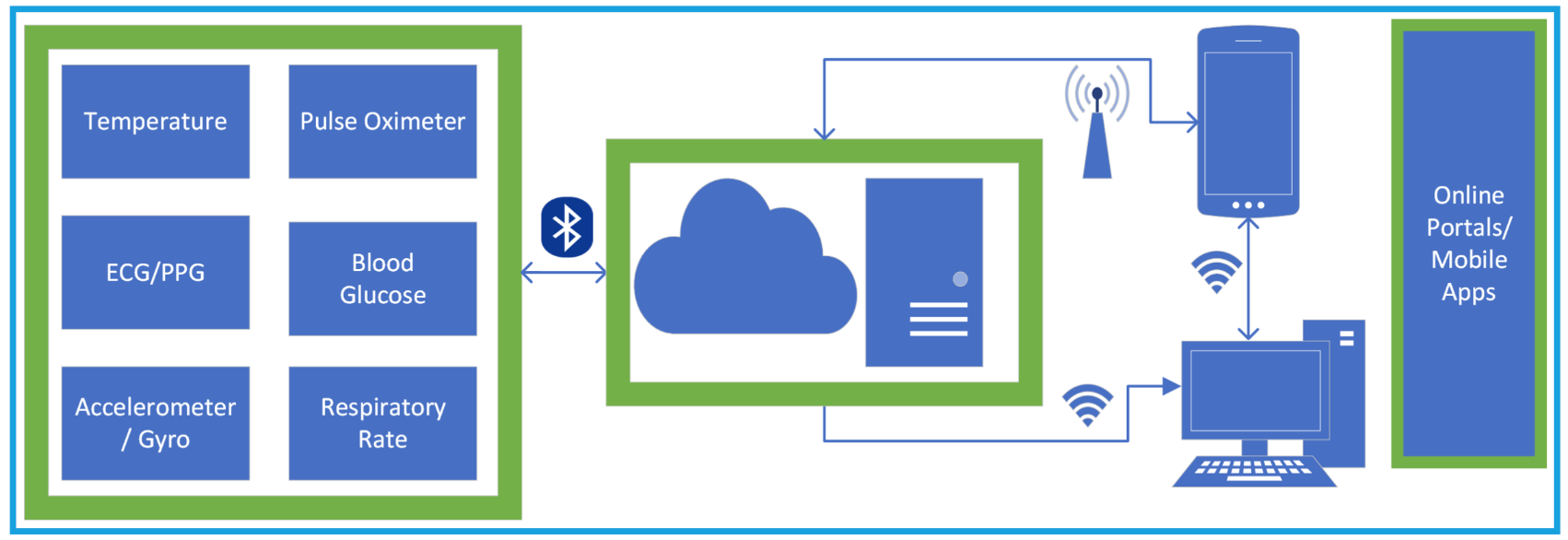This era of the digital age has seen the most groundbreaking development in medical systems. Its functioning has completely shifted with the fusion of the Internet of Things (IoT) and Healthcare. It is popularly referred to as the Internet of Medical Things (IoMT), or the Healthcare Internet of Things (IoT). IoT is the interconnection of everyday objects via the internet. It presents a wide array of advantages, ranging from remote patient monitoring to the enhancement of hospital operations. In this article, we will understand its components, applications, and the vast potential it harbors for the future of medical practice.
How does it work? Components in an IoT Healthcare System
Devices and Sensors
Devices and sensors are at the heart of IoT in healthcare. They gather real-time data from patients, medical equipment, and the environment. These devices can be Wearable Fitness Trackers, Implantable Medical Devices, Smart Hospital Beds, and more. Sensors are embedded in these devices. They monitor vital signs, track medication adherence, and record other pertinent patient information.
Data Exchange and Storage
For IoT to function effectively in healthcare, seamless connectivity is crucial. Medical devices and sensors send data to central servers or cloud-based platforms via wireless technologies such as Wi-Fi, Bluetooth, and cellular networks. This constant data exchange allows healthcare professionals to access patient information in real-time. It facilitates prompt decision-making remotely.
Data Analysis and Notification
The enormous amount of data generated by IoT devices requires robust storage solutions. Cloud-based storage systems help to manage and store patient data. These are secure, scalable, and accessible. Advanced data analytics tools process this information. Extraction of valuable insights aids in diagnosis, treatment planning, and personalized patient care. AI algorithms can analyze the vast amount of data collected by IoT devices. It can help doctors and healthcare professionals make better diagnoses and treatment recommendations. Predictive models can analyze this data and provide timely alerts. This shifts healthcare from reactive to proactive healthcare. It allows for early interventions and prevention in the progression of diseases. It helps to improve patient outcomes.
What are the IoT-based Applications in Healthcare?
Remote Patient Monitoring: IoT-enabled devices have revolutionized remote patient monitoring. They allow healthcare providers to track patients’ health conditions outside traditional clinical settings. Patients with chronic illnesses, post-operative cases, or those requiring continuous monitoring can wear devices like heart rate monitors, blood glucose sensors, and even smart clothing. These devices transmit real-time data to healthcare professionals. Enabling early intervention and reducing hospital readmission.
Smart Medical Devices: IoT has given new life to traditional medical devices, turning them into intelligent tools. For example, portable devices use laser for the treatment (no heat, sound, or vibration) of soft tissue damage. Transcutaneous electrical nerve stimulation helps in pain relief. It involves the use of mild electric current. For example, smart thermometers and blood pressure cuffs automatically record measurements. It reduces the need for manual tracking and data entry.
Hospital Operations Optimization: Efficient hospital operations are essential for providing quality patient care. IoT applications optimize various aspects of healthcare facilities. Ranging from asset management to energy consumption. Smart inventory systems track medical supplies, ensuring that essential items are always available. The Pill dispenser is used for the dispersal of medicines based on the medications prescribed by the doctor. Medicine storage and refilling automation for hospitals can be synchronized over wireless communication with on-premise pharmacy stores. IoT-enabled energy management systems adjust lighting, heating, and cooling based on occupancy. This leads to cost savings and reduced energy waste.
Use case of Remote Patient Monitoring
Let us understand this with a use case of a Remote Patient Monitoring:
 Image 1: Remote Patient Monitoring
Image 1: Remote Patient Monitoring
Based on the end user’s requirement, the sensor sub-system can be customized to measure the necessary vitals of the patient. The sensors sub-system can have a variety of devices and sensors. Typically, these sensors are combined into a wireless patient monitor. The wearable device can be attested to the human body in such a way that they can measure multiple parameters of the body.
The sensors can be:
- Temperature Sensors: To detect fever, hypothermia, or hyperthermia. To indicate various medical conditions.
- Pulse Oximeters: To measure oxygen saturation levels. Monitor respiratory health. Detect conditions like sleep apnea and COPD (Chronic Obstructive Pulmonary Disease).
- ECG/PPG Sensors: Electrocardiogram (ECG) and Photoplethysmography sensors are used to measure the electrical activity of the heart oxygen saturation, blood pressure and cardiac output. Essential for diagnosing arrhythmias and other heart conditions.
- Blood Glucose Sensors: To track blood glucose levels in real-time to manage insulin levels. Continuous glucose monitors (CGMs) are used by diabetic patients.
- Accelerometer and Gyroscope Sensors: Accelerometers and gyroscopes track a patient’s movement and activity. These are often used in wearable fitness trackers and fall detection systems for the elderly.
- Respiratory Rate Sensors: To monitor a patient’s breathing rate and pattern. They are also used for conditions like asthma and to detect irregular breathing.
Apart from the above mentioned, there are several other sensors such as:
Environmental sensors monitor air quality, temperature, humidity, and pollution levels. They can also detect allergens or pollutants that may affect a patient’s health. Medication adherence sensors for medication packaging. Also, to check whether a patient has taken their prescribed medications. Proximity sensors to track the movement of patients and staff. Help to maintain social distancing and prevent the spread of infectious diseases.
Radio-frequency identification (RFID) tags are used for tracking and identifying medical equipment. Pressure sensors are used in smart beds and cushions to monitor a patient’s posture. It also helps detect bedsores and provides comfort adjustments. Wearable Cameras consisting of image sensors help to capture visual data. It can be used for telemedicine, remote wound monitoring, and even detecting skin conditions. These sensors are not specific to the use case mentioned here yet are extremely helpful for the development of a Smart Hospital.
The vital parameters and activities can be monitored continuously. Wireless wearable patient monitors are tied to the human body in such a way that they can measure multiple parameters of the body. These wearable devices can be in the form of sensor-hub patches attested to the patient’s body or worn like a watch or a ring. Devices transmit the patient’s vital information via BLE. Connected to the user’s phone or a gateway device. Monitors are typically battery-powered and have low operating currents, to work for longer battery life. These devices are water and temperature-resistant and of non-allergic material. They are CE / FCC certified. All parts of the system require ultralow power, embedded controllers, and low-power RF for communication.
The wearable device collects data. It transmits data to the patient’s healthcare provider through a cloud-based platform. This real-time data allows medical professionals to closely monitor the patient’s condition. It eliminated the need for them to be physically present in the hospital. In case of any irregularities, the medical team receives instant alerts, enabling them to intervene promptly. The data is collected with the patient’s consent, ensuring transparency in data usage. The collected data is employed with robust encryption techniques.
Data download and analysis adhere to healthcare IoT regulations and compliance frameworks such as HIPAA (Health Insurance Portability and Accountability) and GDPR (General Data Protection Regulation). This is necessary to ensure data security and patient privacy. AI algorithms help doctors and healthcare professionals make better diagnoses and treatment recommendations. Predictive modeling on this data can be helpful to indicate the onset of diseases. The data is available for visualization through mobile applications or online portals. This enables telemedicine.
Why choose IoT Integration in Healthcare? Its benefits:
There are many use cases such as smart patient monitoring systems that exemplify the benefits of IoT integration in Health care. A few prominent of them are as follows:
Enhanced Patient Monitoring and Management
IoT devices have revolutionized patient monitoring. Wearable devices such as smartwatches, fitness trackers, and medical wearables can continuously monitor heart rate, blood pressure, glucose levels, and other crucial metrics. Enabling immediate intervention when necessary. A striking example of this is the use of wearable glucose monitors for diabetes patients.
Real-time Data Access for Healthcare Professionals
With IoT-enabled medical devices, doctors and nurses can remotely monitor patients. They can make informed decisions promptly. For example, a patient with a history of cardiac issues would need frequent visits to the hospital to ensure their heart’s health. However, with IoT technology, a wearable cardiac monitor has been placed on the patient. This device continuously tracks the patient’s heart rate, rhythm, and other vital metrics.
Improved Diagnosis and Treatment
IoT devices contribute to continuous data collection. It helps healthcare professionals gain insights into patient behaviors. These insights aid in tailoring treatment approaches, medication regimens, and lifestyle recommendations. For example, IoT-integrated diagnostic tools, such as Smart imaging devices. These devices help surgical teams easily capture still images and 4K/HD/3D video. They send or live stream them across the hospital network. And enable more precise and efficient diagnoses, leading to better patient outcomes.
Prevention and Early Intervention
Preventive healthcare is a key aspect of modern medicine, and IoT plays a pivotal role in this area. Analysis of historical and real-time patient data helps identify patterns and risk factors. For instance, IoT devices can remind patients to take medications, follow exercise routines, and maintain healthy habits. It reduces the likelihood of disease progression.
Streamlined Hospital Operations and Cost Savings
Beyond patient care, IoT integration can help hospital operations and cost management. IoT-enabled asset tracking systems help hospitals manage medical equipment, supplies, and inventory. Predictive maintenance of medical devices reduces downtime and prevents disruptions in patient care. Additionally, energy management systems driven by IoT technology optimize resource consumption. They lead to reduced energy costs and a smaller carbon footprint. For example, an IoT-based asset management system to keep track of critical equipment such as ventilators, infusion pumps, and defibrillators.
Conclusion:
The integration of IoT in healthcare systems heralds a new era of patient care and operational efficiency. The ability to collect and analyze real-time data from medical devices and sensors empowers healthcare professionals. It helps to make informed decisions, deliver personalized treatments, and enhance overall patient outcomes. With its potential to save lives, reduce costs, and improve the patient experience, IoT is undoubtedly a transformative force in the realm of healthcare.
Reference Links:
https://www.ti.com/lit/ug/tidudo6b/tidudo6b.pdf?ts=1696919934797
https://www.freepik.com/free-vector/intelligent-patch-horizontal-banner_3949318.htm#&position=0&from_view=search&track=ais
https://ieeexplore.ieee.org/document/8124196

 Image 1: Remote Patient Monitoring
Image 1: Remote Patient Monitoring